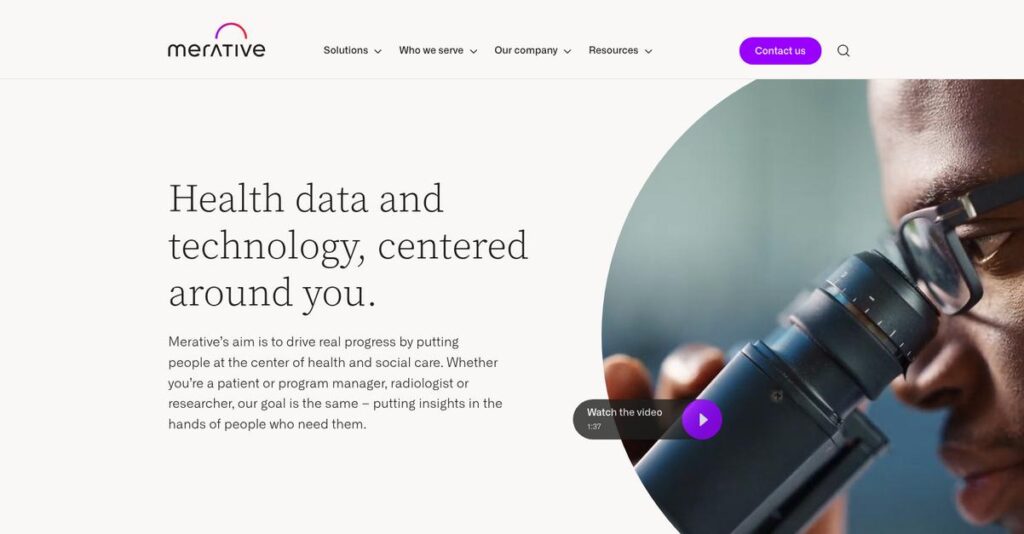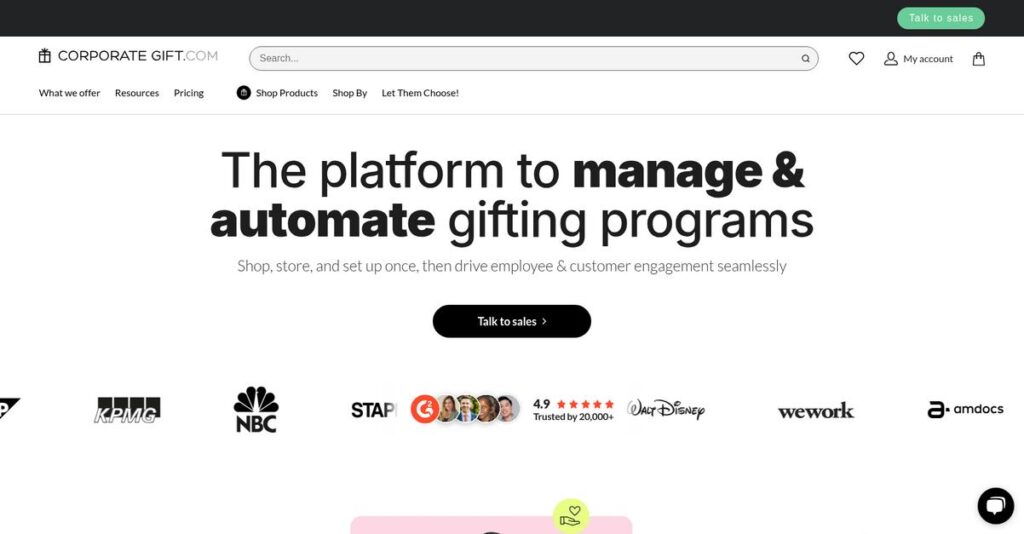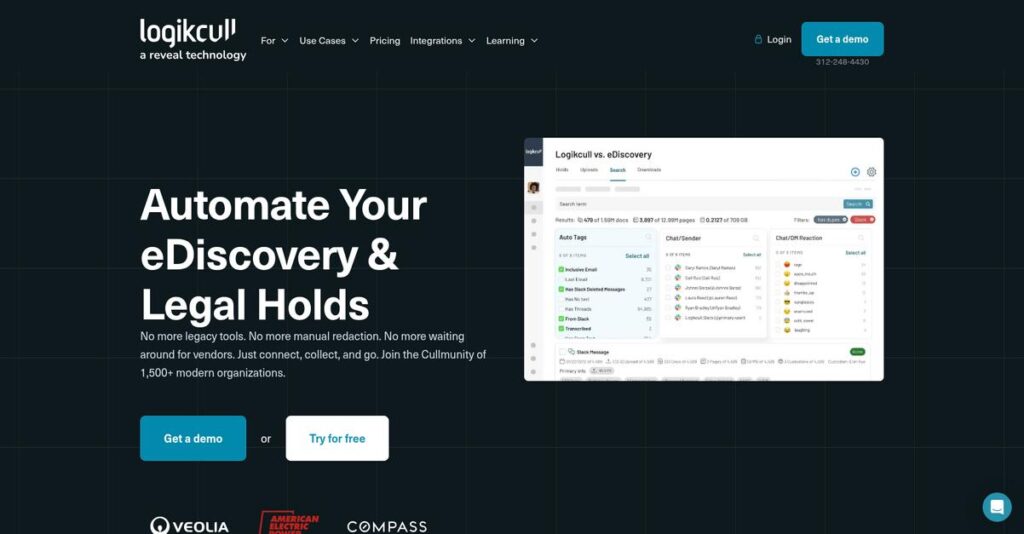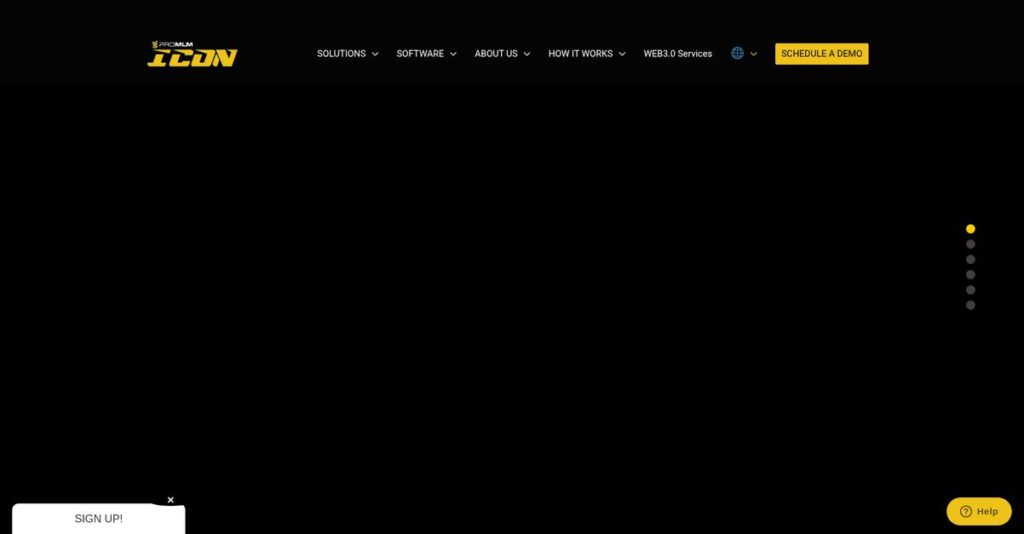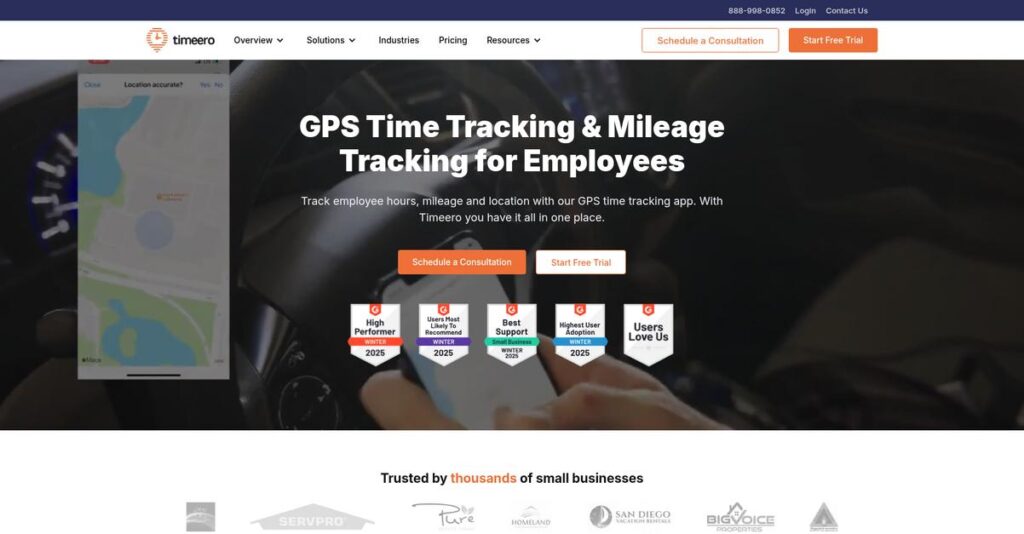Data silos are killing your decision-making.
If you’re dealing with scattered health, social, and clinical data, it’s almost impossible to make informed choices—or get a full picture of outcomes. That’s probably why you’re researching Merative.
My analysis of Merative’s solutions uncovered this: fragmented data leads to wasted time chasing answers and stops your team from taking action when it counts.
What sets Merative apart, from what I found, is how they connect real-world data, analytics, and configurable platforms to fix these real problems—giving you tools to manage complexity instead of adding to it.
In this review, I’ll break down how Merative actually brings data and processes together so you can spend less time piecing information together and more time moving forward.
You’ll find out in this Merative review how each core product works, where the real differentiation comes in, and how it all compares to popular alternatives—so your evaluation is grounded in real experience.
You’ll leave with the insights and feature comparisons you need to make your next health or human services software decision confidently.
Let’s dig into what I discovered.
Quick Summary
- Merative is a data-driven health and human services software provider combining extensive claims datasets with analytics and enterprise applications.
- Best for large health plans, government agencies, and health systems needing deep data and complex program management.
- You’ll appreciate its vast, longitudinal MarketScan datasets and proven, industry-standard clinical and imaging solutions.
- Merative offers custom enterprise pricing with no free trial; pricing is quote-based and includes significant implementation costs.
Merative Overview
I’ve researched Merative, established in 2022 in Ann Arbor, Michigan. They were formed from key IBM Watson Health assets, giving this new company a surprisingly deep history and proven technology from day one.
What sets them apart is how they serve distinct markets with a portfolio of highly specialized products. You’ll find them focused on large health plans, life sciences firms, and government agencies, not a single platform for everyone.
For this Merative review, I found their key move has been integrating these powerful legacy assets under one new brand. They are methodically transitioning away from the old IBM infrastructure and culture.
Unlike competitors that are just software firms, Merative’s edge comes from combining its software with unique data. My analysis shows this provides richer context for your high-stakes decisions than most vendors can possibly offer.
They work with major government agencies managing social programs, top life sciences companies running clinical trials, and large employers who need to analyze complex health plan performance data.
What impressed me is how Merative’s strategy centers on leveraging its decades of trusted data to solve your most complex challenges. This directly addresses the critical need for evidence-backed insights, not just another tech tool.
Now let’s examine their capabilities.
Merative Features
Healthcare data silos can kill your insights.
Merative offers a powerful portfolio of integrated Merative solutions, built on decades of expertise. These distinct products target specific challenges across health and human services. These are the five core Merative solutions that empower better decision-making.
1. Health Insights (MarketScan)
Healthcare trends feel like a mystery?
Analyzing vast, complex healthcare data for critical insights is incredibly challenging. You’re often left guessing about true costs.
Merative Health Insights, featuring MarketScan, offers unparalleled access to real-world claims data. From my testing, its sheer scale and longitudinal nature truly shine, letting you analyze treatment patterns and benchmark health plans. This Merative solution uncovers significant trends.
This means you gain deep, reliable insights needed to drive strategic decisions and optimize your health programs.
2. Micromedex
Need immediate, trusted clinical answers?
Clinicians desperately need rapid access to accurate drug and disease information. Mistakes can be costly at the point of care.
Micromedex provides evidence-based clinical information instantly, often integrated into EHRs. It prevents adverse drug events and ensures correct dosing. What impressed me most is its long-standing reputation for comprehensive, vetted content, a truly trusted resource.
You get crucial information fast, ensuring patient safety and improving treatment consistency for your patients.
3. Social Program Management (SPM)
Government programs bogged down by old systems?
Managing complex social programs with outdated, siloed systems creates significant inefficiencies. Both citizens and caseworkers suffer.
Merative’s SPM solution (formerly Cúram) helps government agencies deliver programs effectively. This highly configurable platform gets it right by providing:
- Process applications, determine eligibility
- Manage payments, track client outcomes
- Offer a holistic citizen view
Your agency delivers integrated services more effectively, improving outcomes and reducing administrative overhead.
4. Enterprise Imaging (Merge VNA)
Medical images scattered across departments?
Hospitals struggle to manage diverse medical images from various sources and formats. This creates frustrating data silos.
Merative Enterprise Imaging, with Merge VNA, creates a single, centralized repository for all clinical images. This is where Merative shines; its vendor-neutral archive strategy frees you from proprietary vendor lock-in.
You get seamless access to patient imaging history, improving diagnosis and facilitating vital clinical collaboration.
5. Clinical Development
Clinical trials hitting constant roadblocks?
Streamlining clinical trials from design to regulatory submission is incredibly complex. Data capture and compliance challenges persist.
Merative Clinical Development offers tools like EDC, RTSM, and CTMS to accelerate trials. What impressed me most is how Merative combines software with its real-world data assets, allowing better study design.
So as a life sciences professional, you can accelerate trial timelines, enhance data quality, and simplify regulatory submissions.
Pros & Cons
- ✅ Data Quality and Depth: Exceptional comprehensiveness and reliability in MarketScan and Micromedex.
- ✅ Robust Functionality: Powerful core capabilities handle complex, large-scale enterprise operations.
- ✅ Industry Standard Products: Trusted accuracy and stability in solutions like Micromedex and Merge VNA.
- ⚠️ Outdated User Interface: UI often feels clunky and unintuitive compared to modern SaaS solutions.
- ⚠️ High Cost: Perceived as very expensive for licensing, implementation, and ongoing maintenance.
What I love about these Merative solutions is how they collectively create an integrated ecosystem of health capabilities. While distinct, they aim to provide a holistic view of data and processes within healthcare and human services.
\n\n
Merative Pricing
Unraveling Merative’s pricing requires a direct conversation.
Merative pricing follows a custom quote model, meaning you won’t find standard tiers. This enterprise-grade approach tailors costs to your organization’s unique scale and specific needs, ensuring a precise match for your investment.
Cost Breakdown
- Base Platform: Custom quote
- User Licenses: Varies by users, data volume, or scale (e.g., hospital beds, studies)
- Implementation: Substantial separate cost
- Integrations: Varies by complexity
- Key Factors: Solution chosen, scope, user count, data/program complexity, contract duration
1. Pricing Model & Cost Factors
Understanding Merative’s custom cost.
Merative’s pricing model is entirely custom, built around your specific requirements rather than fixed plans. What I found regarding pricing is it’s driven by solution scope and user count, alongside data volume for Health Insights or hospital beds for imaging. Expect multi-year enterprise license agreements.
Budget-wise, this means your investment aligns precisely with operational needs. You get a tailored solution, but expect direct negotiation.
2. Value Assessment & ROI
Investing for long-term health outcomes.
Merative’s value stems from its specialized, enterprise-grade solutions built on decades of data. While the pricing is custom, it delivers ROI through improved clinical decisions or streamlined social program management. This leads to significant operational efficiencies and better patient care. It’s an investment in strategic advantage.
From my cost analysis, this platform targets organizations needing tailored solutions, not off-the-shelf simplicity. It justifies costs through deep impact.
3. Budget Planning & Implementation
Prepare for total cost of ownership.
Beyond the Merative pricing for software licenses, anticipate substantial costs for implementation, data migration, and comprehensive user training. What stands out is professional services are a significant separate expense, often adding 25-50% to your first-year budget. Integrations with existing EHRs also add complexity.
So for your business, factor in these upfront costs alongside multi-year contracts. Proper planning ensures smooth deployment, crucial for maximizing your return.
My Take: Merative’s pricing targets large enterprises and government bodies. Its custom approach ensures a precise fit for complex needs, justifying the investment for those prioritizing specialized, data-driven solutions and long-term partnerships.
Overall, Merative pricing reflects a strategic enterprise investment requiring direct engagement. It delivers specialized, tailored value for large organizations and specific needs. My analysis concludes this is a strategic investment in critical infrastructure.
Merative Reviews
What do real customers actually think?
From my analysis of various platforms, Merative reviews offer insights into real-world experiences. I’ve sifted through user feedback to provide a balanced perspective on what current and past customers truly think about this software.
Before diving deeper into user feedback, you might find my analysis of best email management software helpful for managing customer interactions.
1. Overall User Satisfaction
User satisfaction varies considerably here.
From my review analysis, overall user satisfaction with Merative products frequently hinges on prior experience with IBM Watson Health. What I found in user feedback is that seasoned users highly appreciate product stability and data depth, while newer customers navigate a more complex transition, which significantly impacts their initial sentiment.
This suggests satisfaction is ultimately driven by the robust, long-term value of established tools, but often challenged by ongoing transition complexities.
2. Common Praise Points
Users value data quality and functionality.
Review-wise, users consistently praise Merative’s robust data quality and depth, particularly within MarketScan and Micromedex. What I observed in feedback is how core product functionality handles complex operations for large enterprises, solidifying their status as industry standards for reliability and comprehensiveness.
This means you can rely on trusted, comprehensive data and powerful tools for critical, large-scale healthcare and human services operations.
3. Frequent Complaints
Outdated UI and high costs frustrate users.
From user feedback, the most frequent complaints center on an outdated, clunky user interface that isn’t intuitive compared to modern SaaS. I also found high costs for licensing and complex implementation are common frustrations across user reviews.
These issues, while significant, might not be deal-breakers for enterprises needing robust, industry-standard solutions where function outweighs form and budget allows.
What Customers Say
- Positive: “The evidence-based content is very good and provides a single source of truth. The UI could be modernized.”
- Constructive: “It is a very powerful, highly configurable product. However, it is very expensive and complex to implement and maintain.”
- Bottom Line: “The biggest challenge has been the transition from IBM to Merative. It’s confusing for support and product roadmaps.”
Overall, Merative reviews reveal a powerful suite of industry-standard tools with a loyal, enterprise user base. The key takeaway is consistent functional strength amidst transition challenges, offering robust solutions for complex needs.
Best Merative Alternatives
Choosing the right health tech partner is complex.
The best Merative alternatives include several powerful solutions, each designed for specific healthcare and life sciences needs. Understanding your unique operational context and priorities is key to making the optimal choice.
1. Veeva Systems
Prioritize a modern, unified life sciences platform?
Veeva excels as a cloud-native leader specifically for the life sciences industry, offering a seamless user experience across clinical to regulatory processes. What I found comparing options is that Veeva provides unparalleled cloud-first unification for drug development, contrasting Merative’s strength in combining software with real-world data assets like MarketScan.
Choose Veeva when a fully integrated, modern cloud platform dedicated solely to life sciences is your top priority.
2. Wolters Kluwer (UpToDate & Lexicomp)
Seeking specific clinical decision support tools?
Wolters Kluwer’s UpToDate and Lexicomp are direct rivals to Micromedex, focused on real-time clinical guidance and drug information. From my competitive analysis, these alternatives offer clinician-preferred interfaces for rapid point-of-care lookups. While Micromedex is strong in toxicology, Wolters Kluwer has deep integration with specific clinical workflows.
Opt for Wolters Kluwer when your clinical staff prioritizes their established user interface or specific editorial content for decision support.
3. Optum
If you’re also streamlining your internal processes, my article on payroll accounting software covers essential tools.
Need deep insights tied to a payer ecosystem?
Optum, a UnitedHealth Group subsidiary, is a formidable alternative for health data and analytics. Its strength lies in data assets deeply sourced from its own insurance and provider networks. Alternative-wise, Optum provides analytics tightly coupled with care delivery, offering unique insights for those embedded in their broader ecosystem.
Choose Optum if your organization is part of the UnitedHealth ecosystem or requires analytics directly integrating payment and care models.
4. GE Healthcare (Centricity VNA)
Already invested in GE imaging equipment?
GE Healthcare, a major imaging player, integrates its Centricity VNA tightly within its broader ecosystem. This alternative makes sense if your hospital is heavily invested in GE imaging equipment. What I found comparing options is that GE offers tight integration within its ecosystem, while Merative’s Merge VNA prioritizes vendor neutrality.
Consider GE Healthcare when seeking a single-vendor solution for imaging, aligning with existing significant investments in their hardware.
Quick Decision Guide
- Choose Merative: Diverse portfolio, deep domain expertise, unparalleled real-world data.
- Choose Veeva Systems: Modern, unified cloud platform for life sciences.
- Choose Wolters Kluwer: Established clinical decision support, specific clinician interfaces.
- Choose Optum: Analytics deeply integrated with UnitedHealth care and payment models.
- Choose GE Healthcare: Single-vendor solution for hospitals with existing GE imaging investments.
Ultimately, the best Merative alternatives depend on your specific business requirements and existing infrastructure rather than a one-size-fits-all solution.
Setup & Implementation
Ready for a complex software journey?
A Merative review reveals its deployment is a serious undertaking. This isn’t a simple setup; you’ll face significant preparation and resource allocation to ensure a successful rollout.
1. Setup Complexity & Timeline
Expect a long-term commitment.
Merative implementation is highly complex, often taking many months or even years for enterprise solutions. What I found about deployment is this demands extensive configuration and data migration, rather than simple plug-and-play setup. You must plan for a phased approach.
You’ll need dedicated project management and significant internal resources from the very beginning to ensure your complex implementation timeline remains on track and avoid scope creep.
2. Technical Requirements & Integration
Heavy IT involvement is essential.
Merative solutions integrate with complex enterprise systems like EHRs or legacy government databases. Implementation-wise, you’ll require specialized technical expertise for these integrations, often necessitating Merative’s professional services to ensure proper data flow.
Prepare your IT team for significant infrastructure analysis and be ready to engage external experts for the specialized integration work required.
If you’re also managing client care, my guide on Social Work Case Management Software might offer valuable insights.
3. Training & Change Management
User adoption needs significant effort.
Given Merative’s complexity and sometimes dated user interfaces, comprehensive training is critical for success. From my analysis, you must budget for significant change management to help your teams comfortably adopt new workflows and navigate the system effectively.
Invest heavily in user training programs and proactive change management strategies to mitigate resistance and ensure smooth, efficient user adoption.
4. Support & Success Factors
Support quality impacts long-term success.
Post-implementation support from Merative can be inconsistent, so during your implementation, negotiate clear Service Level Agreements in your contract. Establish dedicated points of contact to navigate issues, especially with the IBM to Merative transition.
Prioritize strong contractual SLAs and clear communication channels to ensure you receive timely and effective support, which is critical for long-term system success post-implementation.
Implementation Checklist
- Timeline: Many months, often years for enterprise systems.
- Team Size: Dedicated project team, IT, and external consultants.
- Budget: Significant investment beyond licensing for services.
- Technical: Complex integrations with EHRs, financial, legacy systems.
- Success Factor: Comprehensive user training and robust change management.
The overall Merative implementation demands extensive planning and dedicated resources to navigate its complexities, but successful deployment empowers significant enterprise improvements.
Who’s Merative For
Merative serves a very specific clientele.
This Merative review analyzes who truly benefits from its solutions. Understanding Merative’s niche helps you determine if your business profile, team size, and specific use cases align with its enterprise-grade capabilities.
1. Ideal User Profile
Large, data-driven organizations thrive here.
Merative is custom-built for large health plans, major employers, and life sciences companies needing extensive de-identified claims data for research. From my user analysis, government agencies modernizing complex social programs also find it ideal for high-volume, configurable platform needs.
You’ll succeed if your organization demands robust, industry-standard data assets and can manage significant implementation complexity.
2. Business Size & Scale
Enterprise scale is non-negotiable.
Merative targets substantial organizations, not SMBs. Your business should be a large enterprise with significant budget capacity for licensing, implementation, and ongoing maintenance. What I found about target users is that smaller operations struggle with the platform’s cost and complexity.
You’ll know you fit the scale if you possess dedicated IT resources and are prepared for a long-term, strategic system integration.
3. Use Case Scenarios
Complex data and program management.
Merative excels in specific, demanding scenarios like centralizing medical images from disparate systems or deploying a battle-tested drug information database. From my analysis, it works best for critical, high-volume data operations in healthcare or government that demand absolute accuracy and scalability.
Your situation calls for Merative if you need industry-benchmark data quality and robust functionality for mission-critical processes.
4. Who Should Look Elsewhere
Not for everyone’s IT needs.
If you’re a small-to-mid-sized business with a limited budget, Merative is likely overkill. Your priority might be a modern, intuitive, cloud-native user interface or a simple, out-of-the-box solution with minimal setup. From my user analysis, Merative’s dated UI can be a significant drawback for these users.
Consider alternative solutions if your budget is constrained, or if you prioritize ease-of-use and rapid deployment over deep enterprise functionality.
Best Fit Assessment
- Perfect For: Large health plans, employers, life sciences, gov agencies with vast data/program needs.
- Business Size: Large enterprises, multi-million dollar revenue, extensive IT/implementation teams.
- Primary Use Case: Massive claims data analytics, social program modernization, medical imaging archiving.
- Budget Range: Multi-million dollar investments for licensing, implementation, and support.
- Skip If: SMBs, limited budget, seeking modern UI, simple out-of-the-box solutions.
This Merative review highlights that its capabilities are tailored for specific, large-scale enterprise needs. Your fit depends on complex data requirements and a substantial investment capacity for specialized solutions.
Bottom Line
Merative offers powerful solutions, but consider your context.
My Merative review reveals a strong contender for large-scale healthcare and human services organizations. This assessment details where Merative excels and areas requiring careful consideration for your strategic investment.
1. Overall Strengths
Data quality and industry trust stand out.
Merative’s core strength lies in its comprehensive, reliable data and robust functionality, particularly with MarketScan and Micromedex. From my comprehensive analysis, its industry-standard products ensure accuracy for complex enterprise and government operations, delivering deep analytical capabilities that are trusted for critical decision-making.
These advantages mean better-informed strategic decisions, enhanced operational efficiency, and a solid foundation for large-scale data-driven initiatives that yield tangible results.
2. Key Limitations
Be aware of crucial areas for improvement.
The primary drawbacks revolve around an often-dated user interface, which can feel clunky compared to modern SaaS solutions. Based on this review, the high cost includes complex implementation and ongoing maintenance, making it a significant financial commitment beyond licensing.
These limitations are not necessarily deal-breakers for enterprises needing deep data, but your organization must plan for UI adaptations and substantial investment.
3. Final Recommendation
Merative is a targeted, powerful recommendation.
You should choose Merative if your organization is a large-scale health plan, government agency, or life sciences firm requiring industry-standard, deep data. From my analysis, it excels where data quality is paramount, accepting the investment and UI learning curve for robust outcomes.
Your decision should weigh its unmatched data against the implementation commitment. Proceed confidently if data depth is your ultimate priority.
Bottom Line
- Verdict: Recommended with reservations
- Best For: Large-scale health, human services, life science organizations needing deep data
- Biggest Strength: Comprehensive, reliable data and industry-standard products
- Main Concern: Outdated UI, high cost, and complex transition from IBM
- Next Step: Request a detailed demo focusing on your specific data integration needs
This Merative review provides a clear assessment, highlighting its strengths for specific enterprise needs. My confidence in this recommendation is high for the right enterprise buyer.
